
The Diamondback Firearms DB15 pistol in 7.62×39 can include a factory installed Maxim Defense CQB pistol brace. MSRP for this model is $1364. Street prices will be closer to $1000.
Five years ago, I had the opportunity to review the then-new DB15 Pistol in .223/5.56. Diamondback Firearms was roughly two years into their in-house AR pattern rifle and pistol production program at that time. You can find the review HERE if you would like to step back in time a few years. Modern sporting pistols were slowly gaining popularity in 2014, but it was the introduction of the pistol stabilizing brace that really kicked sales of AR-style pistols into overdrive. That introduction took place about a month after publication of the DB15 Pistol review mentioned above.
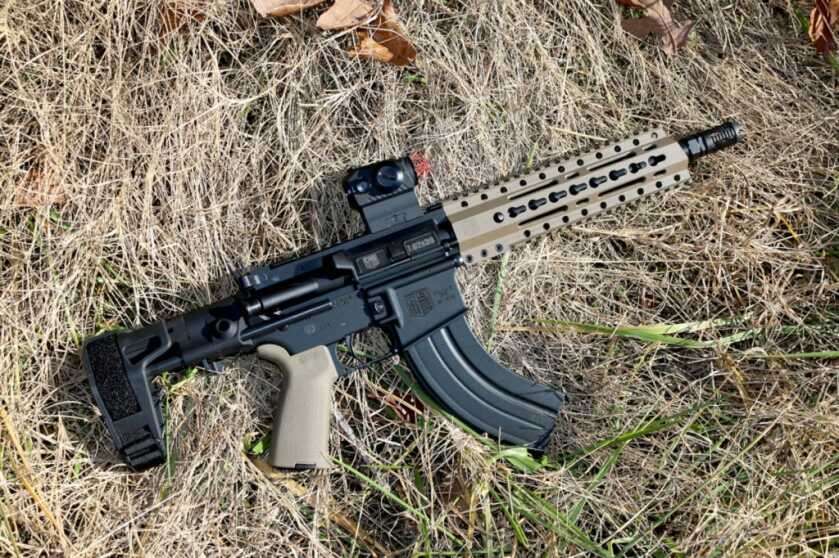
Now I have the opportunity to review another new Diamondback DB15 Pistol. This time chambered in 7.62×39 with a factory installed Maxim Defense CQB Pistol PDW Brace. Diamondback lists several 7.62×39 DB15 Pistol variants in their catalog with options of 7 or 10-inch barrel, handguard/grip color, and stabilizing brace package. As reviewed, the MSRP for this model is $1364. Alternate variations, substituting the Shockwave Blade brace for the Maxim Defense brace, have MSRPs of $872. The approximate street price of the reviewed model is currently around the $1050 mark.

Looking at the pistol specifications, you can see I opted to review the model equipped with the longer 10-inch barrel and more expensive Maxim Defense brace. My rationale for the barrel length was to squeeze as much velocity as possible from the 7.62×39 cartridge. The Maxim Defense brace has been receiving very positive feedback from owners. I was curious to see if my first experience with a Maxim brace equipped AR-style pistol would confirm their impressions. The addition of flat dark earth color accents just seemed to match the intended purpose of the pistol as something I would use primarily for deer and feral hog hunting.
The reviewed DB15 pistol weighed in at six pounds empty. Filling the included C Products Defense 30-round magazine to capacity will add another pound and a half to the total weight. Visual inspection of the pistol revealed no flaws in machining, fit, or finish. Rather than make the entire pistol flat dark earth, Diamondback limited the color accents to the handguard and Magpul MOE pistol grip. Overall, I thought the DB15 Pistol was a good-looking package.
Operating controls are where you would expect to find them on an AR-pattern firearm. Safety and bolt catch on the left side with the magazine release and forward-assist on the right side. The Diamondback single-stage trigger had just a little creep and consistently broke at 7 pounds. With the stabilizing brace collapsed, the extension rails did not hamper the operation of any controls.
Diamondback does not include optics with the DB15 Pistol. You will have to add the optic of your choice before heading out to the range. To aid in this endeavor, the handguard and receiver have full-length Picatinny rail sections. The additional Picatinny rail is available on the underside of the handguard for other accessories. Keymod accessory mounting points run down the right and left sides of the handguard. Diamondback includes a single quick detach mounting point on the left and right side of the handguard. Unfortunately for me, it was positioned right on top of the barrel shank and didn’t offer enough clearance for my QD single point sling swivel.
EMBRACING THE BRACE

This photo montage provides visual support for features of functions of the Maxim Defense CQB Pistol Brace discussed in the review.
The Maxim Defense CQB Pistol PDW Brace for AR15 adds a significant amount to the overall price of the DB15 Pistol. It’s worth a few paragraphs to explain what you get for your money, and how the brace system works. The brace was factory installed by Diamondback, but you can also purchase the brace separately and install it on an AR-style pistol you currently own. The brace system includes a proprietary carbine-length buffer tube, buffer, spring, and a 4-position telescoping brace assembly with sturdy forearm cuff. The quality of all the brace components was outstanding. I particularly liked the Quick Detach mounting points included on both sides of the buffer tube assembly and ultimately used one of these points to attach a single-point sling.
The brace forearm cuff is crafted from a firm rubberized-plastic compound that easily flexes to allow your arm to enter the cuff from the underside of the brace. Another way to say that is that the vertical wings separate and adjust to the size of your arm. The brace can be secured to your forearm using the nylon and Velcro strap to tighten the cuff. The cuff is attached to the buffer tube assembly by two sliding rails. The rails can be locked in four positions. Collapsed, short, medium, and fully extended length. The brace has very little wiggle side to side, or up and down when extended to any of the three available lengths. From the collapsed position, the cuff can be quickly extended to full length with a brisk tug. The adjustment lever, located under the buffer tube, can be used to switch between the available brace lengths, collapse the brace to the closed position, and will also allow the complete removal of the cuff and rail assembly if desired.
The Maxim Defense proprietary H2 (two increments heavier than standard) carbine-length buffer and spring appeared to be perfectly balanced for this pistol. It did the job mitigating some of the 7.62×39 recoil, but wasn’t so overly heavy that it adversely impacted reliable cycling. Overall, the Maxim CQB Pistol Brace is an expensive upgrade, but from my extended use of the brace, it’s worth serious consideration. This was my first opportunity to use a brace-equipped AR-style pistol. The Maxim Defense CQB Pistol brace has definitely elevated my expectations for stabilizing braces in general.
RANGE TIME
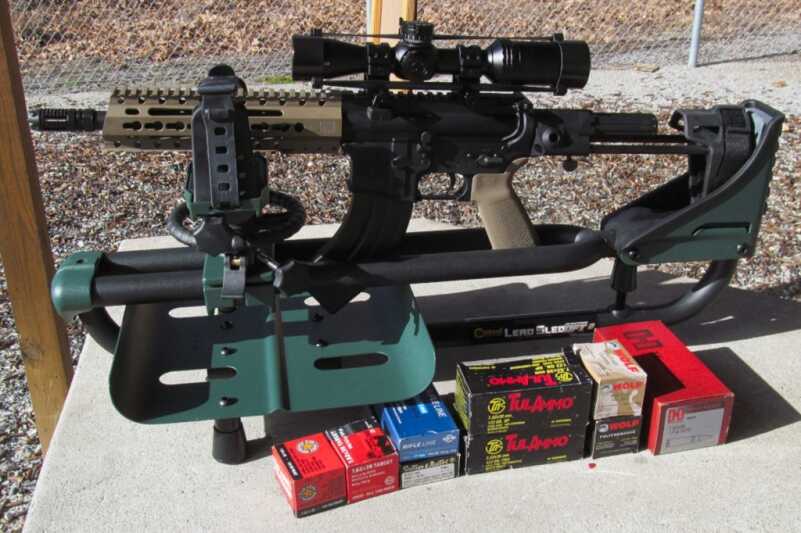
Accuracy testing was done from a solid concrete table using a shooting rest and 7x scope. A variety of steel and brass-cased ammunition was tested throughout the review.
Range work focused on 25, 50, and 100-yard accuracy testing with a variety of ammunition. Primarily large quantities of steel-cased ammunition with some brass-cased ammunition thrown in the mix for good measure. 50 and 100-yard accuracy testing was done from a rest with a Bushnell AR Optics 2-7x scope. A 25-yard shooting was done standing offhand and from improvised rested positions using a Sig Sauer Romeo5 2 MOA red dot sight.

Even at 25 yards, it was clear the DB15 pistol had a preference for certain loads. Accuracy had no correlation with the price of the ammunition.
Starting out at 25 yards with the Romeo5 red dot, it was immediately clear the pistol preferred some loads over others. Wolf Military Classic and Hornady Steel Case SST seemed to print the tightest groups at this distance and that preference would continue throughout the review. It was also during this time that I noted recoil from the 7.62×39 cartridge in this platform was more robust than I remembered experiencing with the .223/5.56 DB15 Pistol previously reviewed. A session with the chronograph explained why.

Velocity from the 10-inch barrel was surprising good. Giving up very little as compared to a barrel twice as long.
I was unsure about the velocity readings I should expect from the 10-inch pistol barrel and a cartridge most often used in a rifle with a 16.3-inch barrel. I was pleasantly surprised to see the velocity penalty from the shorter pistol barrel wasn’t as bad as I thought it might be. Using published velocity data from Sellier & Bellot and Hornady, my velocity measurements were 225 feet per second slower than muzzle velocities generated by each manufacturer’s 20-inch test barrels. Not bad at all. Converting muzzle velocity and bullet weight into foot-pounds of energy yielded values in the 1200 ft/lb. range. More than twice the amount I recorded during my .223/5.56 review. Physics dictates that more energy out the front means more felt recoil for the shooter. Recoil mystery solved.
Along with extra recoil, you can expect 7.62×39 ammunition to be quite loud in this short barrel platform. Hoping to mitigate some of the noise, I took a small detour to try some subsonic ammunition just in case it had enough oomph to cycle the pistol as it does in a full-size AK pattern rifle. I estimated sound on firing to be roughly half that of full-power rounds. Unfortunately, it wasn’t a good match with this pistol and all rounds had to be manually cycled through extraction and loading. It was worth my time to try it and now we know what we can expect when firing subsonic ammunition in this platform.
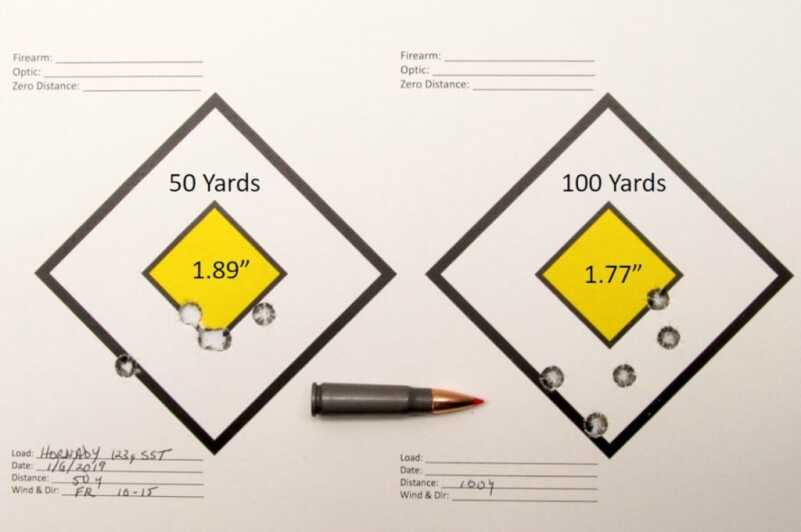
Accuracy at 100 yards was acceptable for deer and feral hog hunting using Hornady Steel Case 123 grain SST ammunition. Other hunting loads may produce even better results.
Replacing the red dot sight with a 2-7x power scope, it was time to see how accurate the pistol would be at distances up to 100 yards. Shooting from a solid rest, sub 3-inch groups at 100 yards were the norm for all the different ammunition brands and bullet weights. I previously had read good things about Hornady Steel Case 123 grain SST ammunition, so I used this as my representative “off the shelf” hunting load for accuracy testing. The Hornady load consistently grouped under 2 inches at 100 yards. 50-yard groups were significantly smaller even though the example in my accompanying photo includes a self-induced flier that opened the group up quite a bit. I chose this picture to demonstrate the limited shift in bullet point of impact at 100 yards when the pistol was zeroed at 50 yards.
Several ammunition importers and all four large US ammunition manufacturers catalog at least one soft-point or ballistic tip hunting load in 7.62×39. If I wasn’t content with sub 2 MOA groups at 100 yards, I could try some other loads, or develop my own handloads for optimum accuracy. From a practical standpoint, I’d probably track down a case of the Hornady Steel Case SST while it’s still available and be satisfied with that until I could work up my own handloads. This ammunition appears to be sufficiently accurate in this pistol for deer and hog hunting at distances up to 100 yards.
Before wrapping up my range work, I had to load up the included 30-round magazine and shoot a few groups offhand at 25 yards with the Romeo5 red dot sight. The pistol and C Products magazine worked perfectly together. I have included a picture of one of those groups below. Firing as fast as I could bring the red dot back on target, I found it a bit challenging to keep all 30 shots in the center of the target. The brace helped tremendously with the recoil control, but that many shots in a row can be little fatiguing as you get to the bottom of the 30-round magazine.
I’ll wrap up my range report with the single issue I encountered in several range visits and 500+ rounds down range. On my final range visit, I had a single failure to fire with one of the steel-cased imported ammunition brands. I recovered and fed the problem round through a second time and it worked fine. After a little research, I discovered there are “enhanced” AR-pattern firing pins available that strike a little deeper on the primer to eliminate this problem with imported 7.62×39 ammunition. It’s something I might consider adding in the future. Which provides us with a nice transition to the wrap-up.
Conclusion
The DB15 7.62×39 is a great example of the modern sporting pistol. It delivers the accuracy, velocity, and sufficient bullet weight required to harvest game at distances to 100 yards. When equipped with a stabilizing brace, 30 caliber rifle cartridge recoil is quite manageable in this platform. Ammunition is currently both plentiful and reasonably priced. 5-round hunting magazines are also plentiful and available from a variety of sources. For those that appreciate the challenge of handgun hunting, or are considering it for the first time, this pistol is worthy of your consideration. Not this particular one though. This one is now mine.
To learn more about the DB15 visit Diamondback Firearms by clicking HERE.
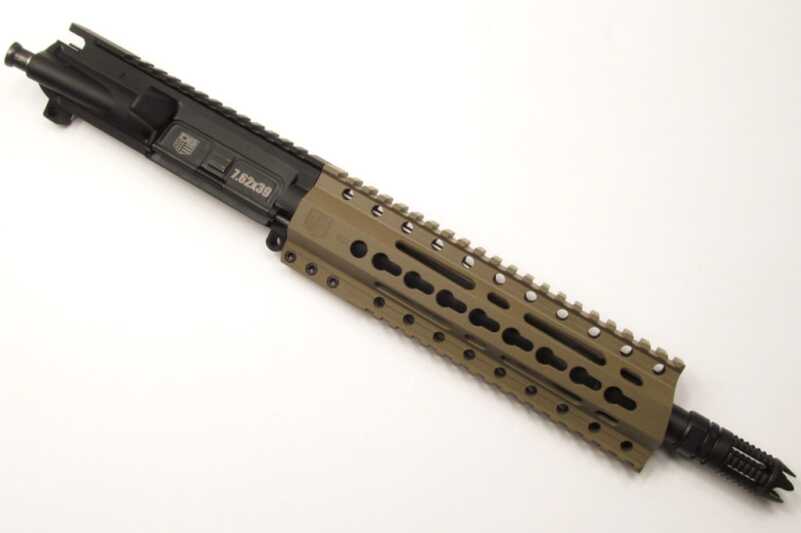
The 9-inch DB15 handguard has plenty of accessory attachment points. The 10-inch barrel is crowned with Diamondbacks removable DBSB muzzle brake. The barrel is threaded 5/8 x 24.
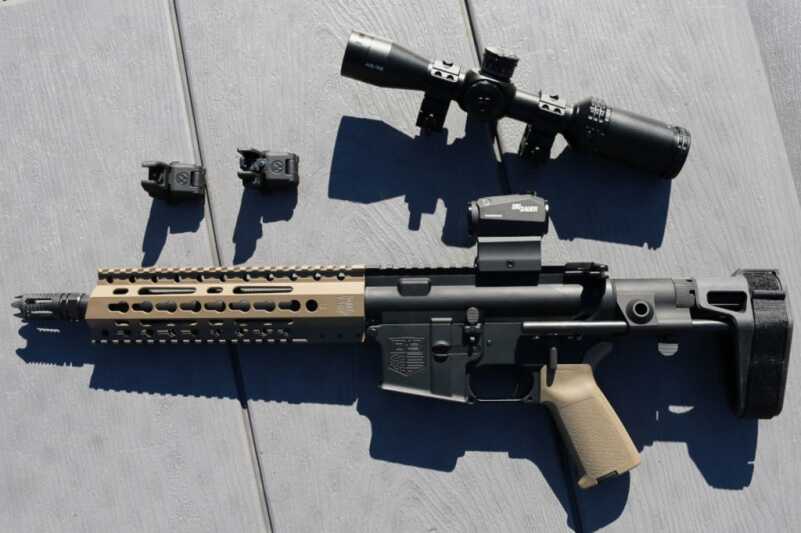
The full-length upper rail allows for attachment of a variety of sights. Iron, red dot, and telescopic sighting systems were all used during the review.

The Diamondback supplied 30-round C Products Defense magazine worked flawlessly. The author found the 5-round ASC magazine more suited to bench rest shooting and will be a more appropriate option for deer and hog hunting.
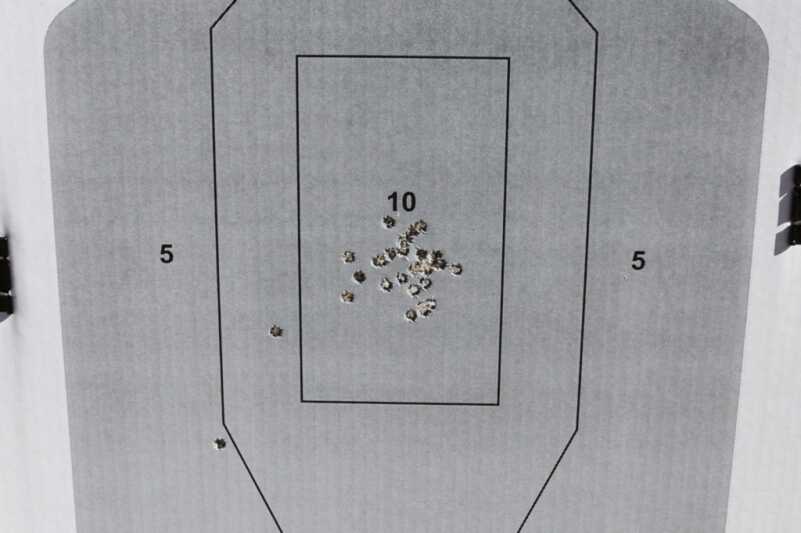
An example 30-round mag dump shot standing offhand at 25 yards with a red dot sight. Just a couple of operator errors in the bunch.

7.62×39 ammunition is loud when fired from a barrel of this length. Some brands of ammunition also treat the operator to a light show.

With the Maxim stabilizing brace collapsed, the D15 pistol easily fits in a racquet sports bag for discreet transportation.
***Shop GunsAmerica for your next DB15***

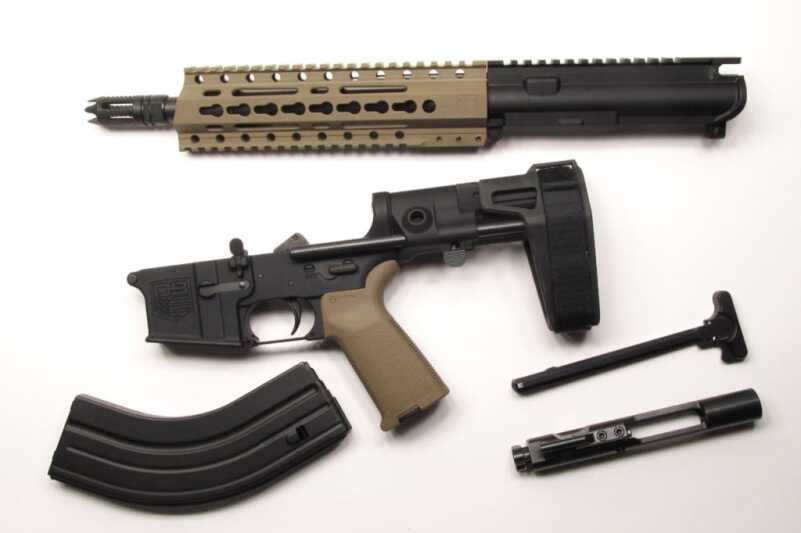
7.62×39 is a beast of a round. But it’s also impractical for a number of reasons. Yes, the ammo is cheap, but performance wise, there are better options. If shit hits the fan here, I doubt there will be a surplus of 7.62 lying about to reload.
Though an invasion is over due, there is the fact that most foreign forces realize our surplus of arms in the civilian population. There are a couple of scenarios where an opposing force could invade theoretically. These being a crumbling infrastructure from renovation, or collapse due to underestimation (think “green new deal”), or mass confiscation of civilian arms (unlikely being resistance chance, but out there nonetheless).
If confiscation be the case, there will already be a civil war in the works. 5.56, 9mm and .45 will be in abundance on the street due to infighting. Practicality would dictate carrying a firearm chambered in such. An invasion would only happen then if there was a clear Victor. Because an outside force would want to fight only one opposition, not two. Especially when those two fronts have the capability to combine.
If collapse of infrastructure be the culprit, there are other factors to keep in mind. But none warrant carrying a foreign cartridge, until invasion Is upon us. Again that would be late in the game however, as word must reach across the pond, battle plans made, etc. Even then it would be slow going (rifle behind every blade of grass and such).
All that being said, as stated, the only thing 7.62×39 has going for it is price at the moment. Surplus rounds tend to have corrosion encoded into it’s DNA. And “shoot and scoot” tactics dictate weapons maintenance. After manufacturing has stopped, there won’t be much to go around aside from what is stockpiled. When investing in something that could, by all means be a fighting weapon, tact needs to be taken into account.
Some back I purchased some Prvi ammo in 123 grain soft point and it will print connecting holes at 100 yards out of my sixteen inch barrel.
Great article thanks for sharing the information.
Thanks for all your time spent shooting and the excellent articles written.
Ted Richardson